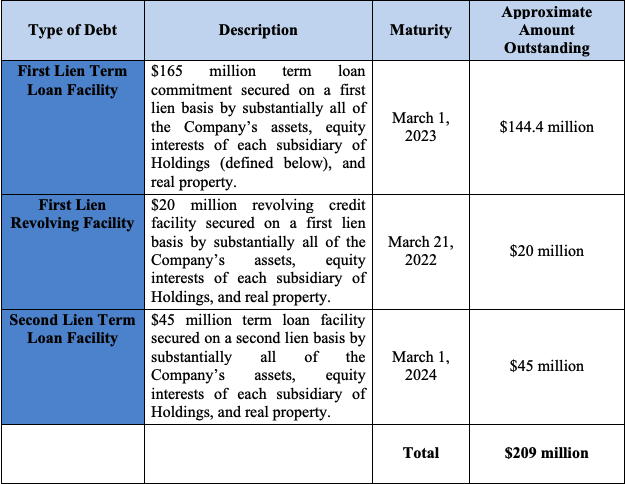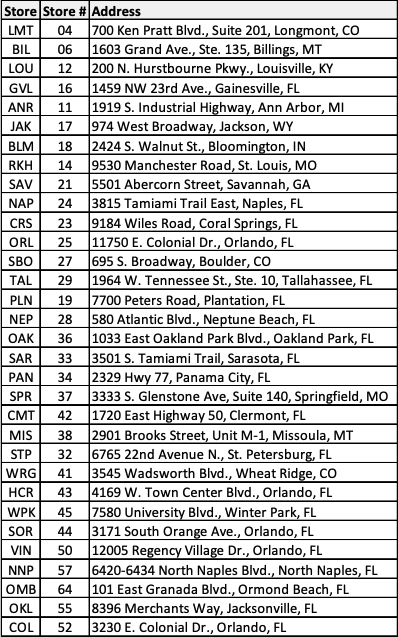⚾️New Chapter 11 Bankruptcy Filing - Modell's Sporting Goods Inc.
Modell's Sporting Goods Inc.
March 11, 2020
There’s nothing particularly new or interesting about another liquidating retailer — especially when it’s just another in a long line of companies in its business segment to file for chapter 11 bankruptcy. Sorry to be callous: we get that Modell’s Sporting Goods Inc. is a family-owned establishment with 134 stores and thousands of employees. We get that people aren’t shopping at brick-and-mortar locations, that Walmart Inc. ($WMT), Target Inc. ($TGT), Amazon Inc. ($AMZN), and, in this category, Dick’s Sporting Goods Inc. ($DKS) are crushing the competition, and that there’s a “decline in sports team participation among youth and teens.” Here’s the number of tackle football participants over the age of six years old in the United States:
This trend in football, however, is not pervasive. Participation in high school baseball, for instance, is on the rise. Most other major high school sports are pretty static, soccer being an exception as that, too, is increasing in popularity. So, sure, okay. We’ll just take the company’s word for it.
But the company doesn’t just blame the youths for its demise; it blames global warming (“warm winter weather in the Northeastern states, which negatively affected the sales of cold-weather goods and items and overall store traffic…”), the crappy-a$$ New York Knicks and disappointing Philadelphia Eagles (“lower than anticipated sales of licensed goods in the fourth quarter of 2019 based on local professional team performance”), and inventory disruption from creditors who’ve gotten sick and tired of getting regularly screwed over by administratively insolvent retailers.
It doesn’t really blame its model. For instance, it doesn’t have any private label apparel. Nor does it own any of its real estate. It is completely beholden to its vendors and foot traffic at strip malls and shopping malls. It leases everything. Apparel merchandise expenses were roughly $225mm/year and rental expenses totaled approximately $95mm/year, constituting approximately 46% and 19% of gross sales ($490mm), respectively. In addition, it has unionized employees. The company is on the hook (jointly with a non-debtor entity) for a pension plan underfunded by $25.8mm.
Of course the company also has debt. It has a unitranche revolving credit facility and term loan with JPMorgan Chase Bank NA and Wells Fargo Bank NA, respectively. As of the petition date, the company owes approximately $39mm under the facility. But as operating performance deteriorated, JPM and WFC became skittish and increased discretionary reserves by $18mm — the nail in the coffin as the company no longer had sufficient liquidity to continue to operate (PETITION Note: Wells Fargo has been particularly savage when it comes to aggressively increasing reserves on its retail clients. We’ve seen this movie before with Pier 1 Imports Inc. and Destination Maternity Inc.). This, despite the company started stretching its vendors and landlords. Rent for February and March went unpaid. The company projects $100mm in general unsecured claims, ex-lease breakage claims.
While the business suffered, multiple attempts to achieve an out-of-court restructuring and/or a sale to a strategic buyer failed. The company will now undertake a coordinated wind down to maximize recoveries for stakeholders. Absent some White Knight swooping in here at the 13th hour, pour one out for Modell’s Sporting Goods Inc.
Jurisdiction: D. of New Jersey (Judge Papalia)
Capital Structure: $29.5mm RCF (JPMorgan Chase Bank NA), $9.225mm Term Loan (Wells Fargo Bank NA)
Professionals:
Legal: Cole Schotz PC (Michael Sirota, David Bass, Felice Yudkin)
Financial Advisor: Berkeley Research Group LLC (Robert Duffy)
Investment Banker: RBC Capital Markets
Real Estate Advisor: A&G Realty Partners LLC
Liquidation Consultant: Tiger Capital Group LLC
Claims Agent: Prime Clerk LLC (*click on the link above for free docket access)
Other Parties in Interest:
JPMorgan Chase Bank NA
Legal: Otterbourg PC (Daniel Fiorillo, Chad Simon) & Norris McLaughlin PA (Morris Bauer, Allison Arotsky)
Wells Fargo Bank NA
Legal: Riemer & Braunstein LLP (Steven Fox)
Local 1102 RWDSU UFCW, Local 1102 Retirement Trust, and Local 1102 Health and Benefit Fund
Legal: Rothman Rocco Laruffa LLP (Matt Rocco) & Lowenstein Sandler LLP (Kenneth Rosen)












